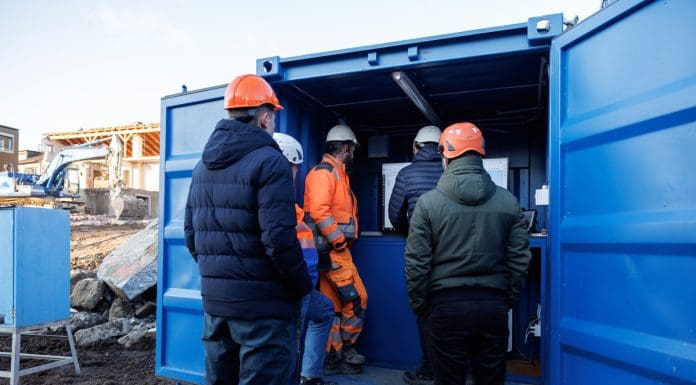At the Build the Future ALLPLAN Summit 2024, KIBAG, one of the leading companies in the Swiss construction and building materials industry presented a pilot project to show what was learned from the almost universal use of BIM in specialist civil engineering construction
KIBAG Infra has already been working with BIM to a high degree for several years. However, a pilot project in Zurich was the first to be realised almost completely based on the BIM model.
The project involved the construction of two new apartment buildings with underground parking. The site is located on a slight slope in a heavily built-up area above the city. An embankment running between the two buildings also posed a particular technical challenge.
BIM2Field, 3D machine control, material orders and target/actual comparisons
Image: © KIBAG
To plan the deep excavation works, an architectural model of the buildings, together with a proposal for the excavation was provided by the client.
KIBAG Infra further developed the latter into a braced soldier pile wall.
The conceptual design during the tender phase – as well as the analysis calculation of the support – was initially carried out as standard using 2D structural analysis programs without reference to the model.
However, the relevant verification sections could already be verified after initial modelling.
BIM2Field was executed using a “BIM container”, which enabled a largely paperless construction site.
The container can be used in any weather and can be easily repositioned using an excavator or crane.
Thanks to the digital BIM container, the execution model could be accessed directly on site via Bimplus – ALLPLAN’s open model-based data and information management collaboration platform for all disciplines involved in construction projects.
A printed plan, derived from the model, was only available as a backup, but was only used by subcontractors who had not been specially trained by KIBAG in using the model.
The execution model was also used to prepare the 3D machine controls for the excavators, as well as the dimensions for material orders and a target/actual comparison.
New terrain data by drone
As two buildings had recently been demolished on the site, which was very difficult to access, and new utility lines had been laid, among other things, both the public geodata and the client’s as-built data were no longer up to date.
For this reason, KIBAG created new drone images of the terrain for further modelling.
Based on the structural model from the structural engineer, which also included the surrounding walls, KIBAG Infra was able to model the deep excavation with the contractor’s variant of the excavation closure.
Communication via Bimplus
During the design phase, there was an exchange between the modeller and the civil engineer. This was deliberately carried out digitally via Bimplus to establish location independent processing for future projects.
The foreman was also involved in the detailed design in order to define what should ideally be recognisable in the model and what information it should contain. For example, at the foreman’s request, the numbering of the beams was integrated into the model using 3D text.
“Thanks to the digital BIM container, the execution model could be accessed directly on site via Bimplus – ALLPLAN’s open model-based data and information management collaboration platform for all disciplines involved in construction projects.”
The foreman was able to read out or measure the required dimensions or stakeouts directly from the model.
The model was always accessed via Bimplus using the container or mobile devices. Issue management in Bimplus was primarily used for questions.
At the same time, the current construction site status was recorded via Bimplus, so that the site management in the office was always aware of the status of the project.
Lessons learned from the BIM pilot project
Model-based construction (BIM2Field) was very well received by the senior site personnel. In fact, the foreman was so impressed by the model that he immediately requested modelling of the utility lines, which were originally planned in 2D.
The direct communication via Bimplus between the designers and engineers proved to be similarly successful. In addition to this positive feedback from those involved, three specific lessons were highlighted from the pilot project:
Every component, be it the thin concrete finished surface layer, a specific use of materials or even their staging, must be modelled so that it can be used accordingly.
Certain information, such as the numbering of components or gradient information, must be clearly visible directly in the model, eg as 3D text, to better facilitate execution. However, the following applies: as much as necessary, as little as possible.
A stable internet connection is extremely important, as connection interruptions lead to problems in cloud-based communication.
For more details on this project watch the video from the ALLPLAN Build the Future event here.
*Please note that this is a commercial profile.
The post Taking BIM onto the construction site: A civil engineering special pilot project appeared first on Planning, Building & Construction Today.


